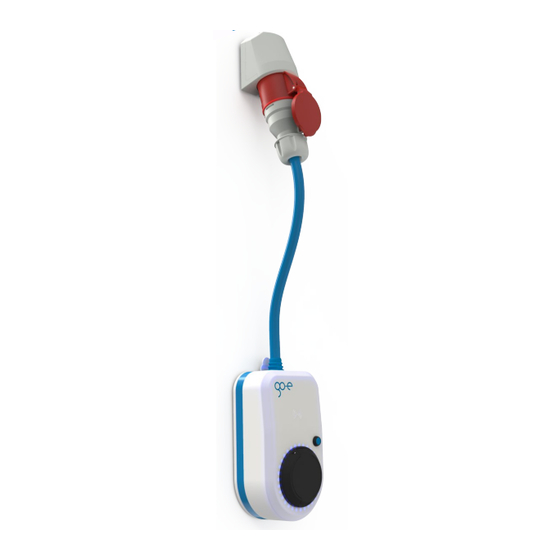
go-e Charger HOME+ Short Instructions
Hide thumbs
Also See for Charger HOME+:
- Operating instructions manual (30 pages) ,
- Quick reference manual (10 pages) ,
- Installation and operating manual (18 pages)
Advertisement
Before installation and initial operation, please note the following:
This quick guide applies to the go-eCharger HOME+ with the power variants 11 kW and 22
kW. Please download the complete user manual and data sheet of your version of the
go-eCharger HOME+ from the go-e website.
The documents can be accessed at www.go-e.co/downloads/?lang=en
Please read the instructions for the device carefully before installation and initial operation
and observe all safety instructions! The complete operating instructions, short instructions
and the data sheet should help you:
WARNING
ATTENTION
¡ to use the product properly and avoid damage
¡ to increase durability and reliability
¡ to prevent a hazard
Mounting of go-eCharger HOME+
The go-eCharger has a built-in RCD protection device with DC current detection (30 mA AC
and 6 mA DC). Therefore an upstream RCD type B is not necessary. The circuit to which the
go-eCharger is connected has to be fitted with an RCCB type A and a miniature circuit
WARNING
WARNING
breaker (MCB), characteristic B and C is permissible, according to the the following
ATTENTION
ATTENTION
specification:
Ÿ
Connection 16/32 A three-phase = 3- or 4-pole MCB for 16/32 A
Ÿ
Connection 16/32 A single-phase = 2-pole MCB for 16/32 A
The device can be installed indoors or outdoors. Provide a power supply. If a three-phase socket is available,
insert the charging unit onto the wall mount and the plug of the charging unit into the socket to determine the
best positioning of the wall bracket.
Then use the mounting plate as a template for marking the drill holes. Use a spirit level to align the wall mount.
Use the screws and dowels supplied to attach the wall bracket. Make sure that there are no distortions on the
surface. If the wall bracket warps, it may not be possible to attach the device. Use spacers to compensate for
any unevenness in the wall.
If there is no three-phase current connection, have the three-phase current socket installed by a qualified
electrician. This qualified person has a recognised electrical engineering qualification which enables him/her to
carry out all electrical engineering work in accordance with the applicable national regulations. You can achieve
a comfortable height for the charging box by having the three-phase socket installed approx. 170 cm above the
floor.
06/21
Short Instructions
ENGLISH
1
Advertisement
Table of Contents

Summary of Contents for go-e Charger HOME+
- Page 1 Please download the complete user manual and data sheet of your version of the go-eCharger HOME+ from the go-e website. The documents can be accessed at www.go-e.co/downloads/?lang=en Please read the instructions for the device carefully before installation and initial operation...
- Page 2 (applies to go-eCharger HOME+ 11 kW) or CEE red 32 A (applies to go-eCharger HOME+ 22 kW) socket (1). For other sockets suitable adapters have to be used. When using original go-e adapters, the current is automatically limited. Do not use adapters from other manufacturers (in this case, the setting of the go-eCharger should not exceed 16 A).
- Page 3 Either scan the QR code on the reset card (an external app may be required for this) or manually search for the charger's network (displayed as go-e-xxxxxx) in the settings of your mobile device to establish a connection to the hotspot. If you connect manually, you have to enter the password that you will find on the reset card under "Hotspot key".
- Page 4 If this is not known, use the lowest charging current. Attention: The go-eCharger HOME+ 22 kW automatically reduces the charging current to 16 A by plugging in the adapter only in conjunction with the original go-e adapters. The go- eCharger HOME+ 11 kW always charges with a maximum of 16 A, regardless of the adapter.













Need help?
Do you have a question about the Charger HOME+ and is the answer not in the manual?
Questions and answers